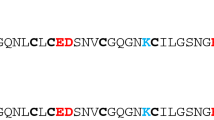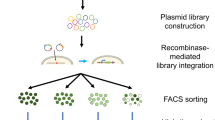Abstract
We constructed a hirudin cDNA cassette, HV-1.1, that encodes mature hirudin variant-1 fused to the signal peptide of human tissue-type plasminogen activator (t-PA). The cassette was subcloned into retroviral vectors and used to transduce human vascular endothelial cells in vitro. Hirudin antigen and activity were measured by ELISA and thrombin inhibition assays, respectively. Transduced cells secreted up to 35 ± 2 ng/106 cells/24 h of biologically active hirudin; expression was stable for at least 7 weeks. Recombinant hirudin, expressed from the HV-1.1 cassette, had a specific activity of 7.1 ± 0.2 antithrombin units per microgram (ATU/μg), compared with specific activities of approximately 12 ATU/μg for both native leech hirudin and recombinant hirudin produced in yeast. Protein sequencing and mass spectroscopic analysis revealed the presence of an extra N-terminal serine residue, indicating aberrant cleavage of the t-PA signal peptide and likely accounting for the diminished activity. We therefore constructed a second cDNA cassette, HV-1.2, in which hirudin secretion was directed by the signal peptide of human growth hormone. Hirudin expressed from the HV-1.2 cassette had a specific activity of 13.5 ± 0.2 ATU/μg. Protein sequencing and mass spectroscopic analysis demonstrated proper cleavage of the growth hormone signal peptide. Thus, we achieved high level retrovirus-mediated secretion of biologically active hirudin from endothelial cells in vitro. Use of these vectors may permit sustained local antagonism of thrombin activity in vivo.
This is a preview of subscription content, access via your institution
Access options
Subscribe to this journal
Receive 12 print issues and online access
$259.00 per year
only $21.58 per issue
Buy this article
- Purchase on Springer Link
- Instant access to full article PDF
Prices may be subject to local taxes which are calculated during checkout





Similar content being viewed by others
References
Mann KG . Prothrombin and thrombin. In: Colman RW, Hirsh J, Marder VJ, Salzman EW (eds) . Hemostasis and Thrombosis: Basic Principles and Clinical Practice, 3rd edn JB Lippincott: Philadelphia 1994 184–199
Sugama Y et al. Thrombin-induced expression of endothelial P-selectin and intercellular adhesion molecule-1: a mechanism for stabilizing neutrophil adhesion J Cell Biol 1992 119: 935–944
Harker LA, Hanson SR, Runge MS . Thrombin hypothesis of thrombus generation and vascular lesion formation Am J Cardiol 1995 75: 12B–17B
McNamara CA et al. Thrombin stimulates proliferation of cultured rat aortic smooth muscle cells by a proteolytically activated receptor J Clin Invest 1993 91: 94–98
Okazaki H, Majesky MW, Harker LA, Schwartz SM . Regulation of platelet-derived growth factor ligand and receptor gene expression by α-thrombin in vascular smooth muscle cells Circ Res 1992 71: 1285–1293
Markwardt F . Hirudin as an inhibitor of thrombin Meth Enzymol 1970 19: 924–932
Talbot MD et al. The effects of recombinant desulphatohirudin on arterial thrombosis in rats Haemostasis 1991 21 (Suppl. 1): 73–79
Just M, Tripier D, Seiffge D . Antithrombotic effects of recombinant hirudin in different animal models Haemostasis 1991 21 (Suppl. 1): 80–87
Brill-Edwards P et al. Prevention of thrombus growth by antithrombin III-dependent and two direct thrombin inhibitors in rabbits: implications for antithrombotic therapy Thromb Haemost 1992 68: 424–427
Sarembock IJ et al. Effectiveness of recombinant desulphatohirudin in reducing restenosis after balloon angioplasty of atherosclerotic femoral arteries in rabbits Circulation 1991 84: 232–243
Topol EJ et al. Recombinant hirudin for unstable angina pectoris. A multicenter, randomized angiographic trial Circulation 1994 89: 1557–1566
Serruys PW et al. A comparison of hirudin with heparin in the prevention of restenosis after coronary angioplasty New Engl J Med 1995 333: 757–763
van den Bos AA et al. Safety and efficacy of recombinant hirudin (CGP 39 393) versus heparin in patients with stable angina undergoing coronary angioplasty Circulation 1993 88: 2058–2066
The Global Use of Strategies to Open Occluded Coronary Arteries (GUSTO) IIa Investigators . Randomized trial of intravenous heparin versus recombinant hirudin for acute coronary syndromes Circulation 1994 90: 1631–1637
Rade JJ, Schulick AH, Virmani R, Dichek DA . Local adenoviral-mediated expression of recombinant hirudin reduces neointimal formation after arterial injury Nature Med 1996 2: 293–298
Newman KD et al. Adenovirus-mediated gene transfer into normal rabbit arteries results in prolonged vascular cell activation, inflammation, and neointimal hyperplasia J Clin Invest 1995 96: 2955–2965
Schulick AH et al. Established immunity precludes adenovirus-mediated gene transfer in rat carotid arteries. Potential for immunosuppression and vector engineering to overcome barriers of immunity J Clin Invest 1997 99: 209–219
Yang Y et al. Cellular immunity to viral antigens limits E1-deleted adenoviruses for gene therapy Proc Natl Acad Sci USA 1994 91: 4407–4411
Flugelman MY et al. Low level in vivo gene transfer into the arterial wall through a perforated balloon catheter Circulation 1992 85: 1110–1117
Nabel EG . Gene therapy for cardiovascular disease Circulation 1995 91: 541–548
Zhu NL et al. Downregulation of cyclin G1 expression by retrovirus-mediated antisense gene transfer inhibits vascular smooth muscle cell proliferation and neointima formation Circulation 1997 96: 628–635
Wilson JM et al. Implantation of vascular grafts lined with genetically modified endothelial cells Science 1989 244: 1344–1346
Dichek DA et al. Seeding of intravascular stents with genetically engineered endothelial cells Circulation 1989 80: 1347–1353
Nabel EG et al. Recombinant gene expression in vivo within endothelial cells of the arterial wall Science 1989 244: 1342–1344
Konno S, Fenton JW II, Villanueva GB . Analysis of the secondary structure of hirudin and the mechanism of its interaction with thrombin Arch Biochem Biophys 1988 267: 158–166
Walsmann P . Isolation and characterization of hirudin from Hirudo medicinalis Semin Thromb Hemost 1991 17: 83–87
Braun PJ . Binding properties of hirudin determined by gel filtration and gel electrophoresis Thromb Res 1990 59: 657–662
Meyer BJ et al. Dissolution of mural thrombus by specific thrombin inhibition with r-hirudin Circulation 1998 97: 681–685
White HD et al. Randomized, double-blind comparison of hirulog versus heparin in patients receiving streptokinase and aspirin for acute myocardial infarction (HERO) Circulation 1997 96: 2155–2161
Chesebro JH . Direct thrombin inhibition superior to heparin during and after thrombolysis Circulation 1997 96: 2118–2120
Bergmann C et al. Chemical synthesis and expression of a gene coding for hirudin, the thrombin-specific inhibitor from the leech Hirudo medicinalis Biol Chem Hoppe Seyler 1986 367: 731–740
Meyhack B et al. Desulfatohirudin, a specific thrombin inhibitor: expression and secretion in yeast Thromb Res 1987 48 (Suppl. VII): 33
Benatti L, Scacheri E, Bishop DHL, Sarmientos P . Secretion of biologically active leech hirudin from baculovirus-infected insect eggs Gene 1991 101: 225–260
Bird P, Gething M-J, Sambrook J . Translocation in yeast and mammalian cells: not all signal sequences are functionally equivalent J Cell Biol 1987 105: 2905–2914
Tessier DC et al. Enhanced secretion from insect cells of a foreign protein fused to the honeybee melittin signal peptide Gene 1991 98: 177–183
Levin EG . Latent tissue plasminogen activator produced by human endothelial cells in culture: evidence for an enzyme–inhibitor complex Proc Natl Acad Sci USA 1983 80: 6804–6808
van Zonneveld A-J, Veerman H, Pannekoek H . Autonomous functions of structural domains on human tissue-type plasminogen activator Proc Natl Acad Sci USA 1986 83: 4670–4674
Devlin JJ et al. Novel expression of chimeric plasminogen activators in insect cells Biotechnology 1989 7: 286–292
Kopfler WP et al. Adenovirus-mediated transfer of a gene encoding human apolipoprotein A-I into normal mice increases circulating high-density lipoprotein cholesterol Circulation 1994 90: 1319–1327
von Heijne G . Patterns of amino acids near signal-sequence cleavage sites Eur J Biochem 1983 133: 17–21
Wiren KW, Potts JT Jr, Kronenberg HM . Importance of the propeptide sequence of human preproparathyroid hormone for signal sequence function J Biol Chem 1988 263: 19771–19777
Matsuoka K, Nakamura K . Propeptide of a precursor to a plant vacuolar protein required for vacuolar targeting Proc Natl Acad Sci USA 1991 88: 834–838
Goeddel DV et al. Direct expression in Escherichia coli of a DNA sequence coding for human growth hormone Nature 1979 281: 544–548
Wallace A, Dennis S, Hofsteenge J, Stone SR . Contribution of the N-terminal region of hirudin to its interaction with thrombin Biochemistry 1989 28: 10079–10084
Zwiebel JA et al. High-level recombinant gene expression inrabbit endothelial cells transduced by retroviral vectors Science 1989 243: 220–222
Connelly S et al. In vivo gene delivery and expression of physiological levels of functional human factor VIII in mice Hum Gene Ther 1995 6: 185–193
Kahn ML, Lee SW, Dichek DA . Optimization of retroviral vector–mediated gene transfer into endothelial cells in vitro Circ Res 1992 71: 1508–1517
Ory DS, Neugeboren BA, Mulligan RC . A stable human-derived packaging cell line for production of high titer retrovirus/vesicular stomatitis virus G pseudotypes Proc Natl Acad Sci USA 1996 93: 11400–11406
Harker L et al. Reduction in vascular lesion formation (VLF) by hirudin secreted from retroviral-transduced confluent endothelial cells on vascular grafts in baboons Thromb Haemost 1997 77 (Suppl.): 585
Dichek DA, Nussbaum O, Degen SJF, Anderson WF . Enhancement of the fibrinolytic activity of sheep endothelial cells by retroviral vector-mediated gene transfer Blood 1991 77: 533–541
Dichek DA, Lee SW, Nguyen NH . Characterization of recombinant plasminogen activator production by primate endothelial cells transduced with retroviral vectors Blood 1994 84: 504–516
Dichek DA et al. Enhanced in vivo antithrombotic effects of endothelial cells expressing recombinant plasminogen activators transduced with retroviral vectors Circulation 1996 93: 301–309
Dunn PF et al. Seeding of vascular grafts with genetically modified endothelial cells. Secretion of recombinant T-PA results in decreased seeded cell retention in vitro and in vivo Circulation 1996 93: 1439–1446
Shayani V, Newman KD, Dichek DA . Optimization of recombinant t-PA secretion from seeded vascular grafts J Surg Res 1994 57: 495–504
Berg DT, Grinnell BW . Signal and propeptide processing of human tissue plasminogen activator: activity of a pro-t-PA derivative Biochem Biophys Res Commun 1991 179: 1289–1296
McLachlin JR et al. Factors affecting retroviral vector function and structural integrity Virology 1993 195: 1–5
Krall WJ et al. Increased levels of spliced RNA account for augmented expression from the MFG retroviral vector in hematopoietic cells Gene Therapy 1996 3: 37–48
Markowitz D, Goff S, Bank A . A safe packaging line for gene transfer: separating viral genes on two different plasmids J Virol 1988 62: 1120–1124
Miller AD, Buttimore C . Redesign of retrovirus packaging cell lines to avoid recombination leading to helper virus production Mol Cell Biol 1986 6: 2895–2902
Spannagl M, Bichler H, Lill H, Schramm W . A fast photometric assay for the determination of hirudin Haemostasis 1991 21 (Suppl. 1): 36–40
Laemmli UK . Cleavage of structural proteins during the assembly of the head of bacteriophage T4 Nature 1970 227: 680–685
Towbin H, Staehelin T, Gordon J . Electrophoretic transfer of proteins from polyacrylamide gels to nitrocellulose sheets: procedure and some applications Proc Natl Acad Sci USA 1979 76: 4350–4354
Johnson PH et al. Structure-function and refolding studies of the thrombin-specific inhibitor hirudin Haemostasis 1991 21 (Suppl. 1): 41–48
Author information
Authors and Affiliations
Rights and permissions
About this article
Cite this article
Rade, J., Cheung, M., Miyamoto, S. et al. Retroviral vector-mediated expression of hirudin by human vascular endothelial cells: implications for the design of retroviral vectors expressing biologically active proteins. Gene Ther 6, 385–392 (1999). https://doi.org/10.1038/sj.gt.3300824
Received:
Accepted:
Published:
Issue Date:
DOI: https://doi.org/10.1038/sj.gt.3300824
Keywords
This article is cited by
-
Gene therapy for vein graft disease
Current Cardiology Reports (2001)



